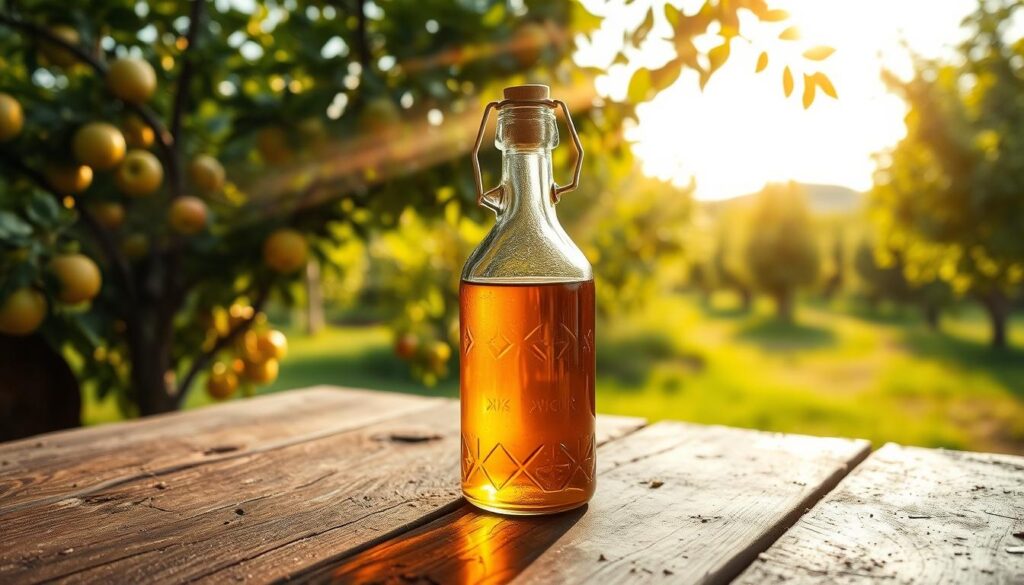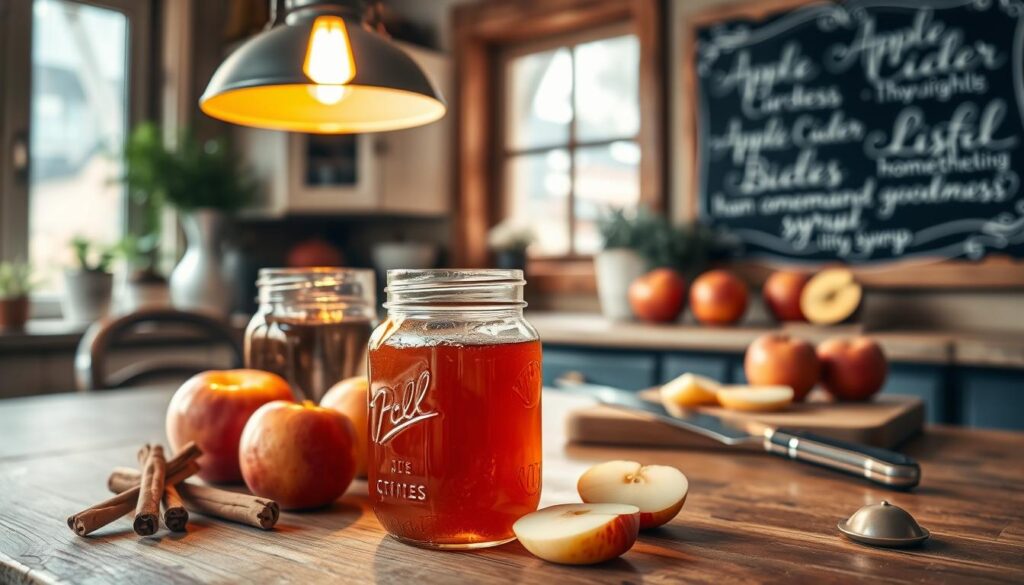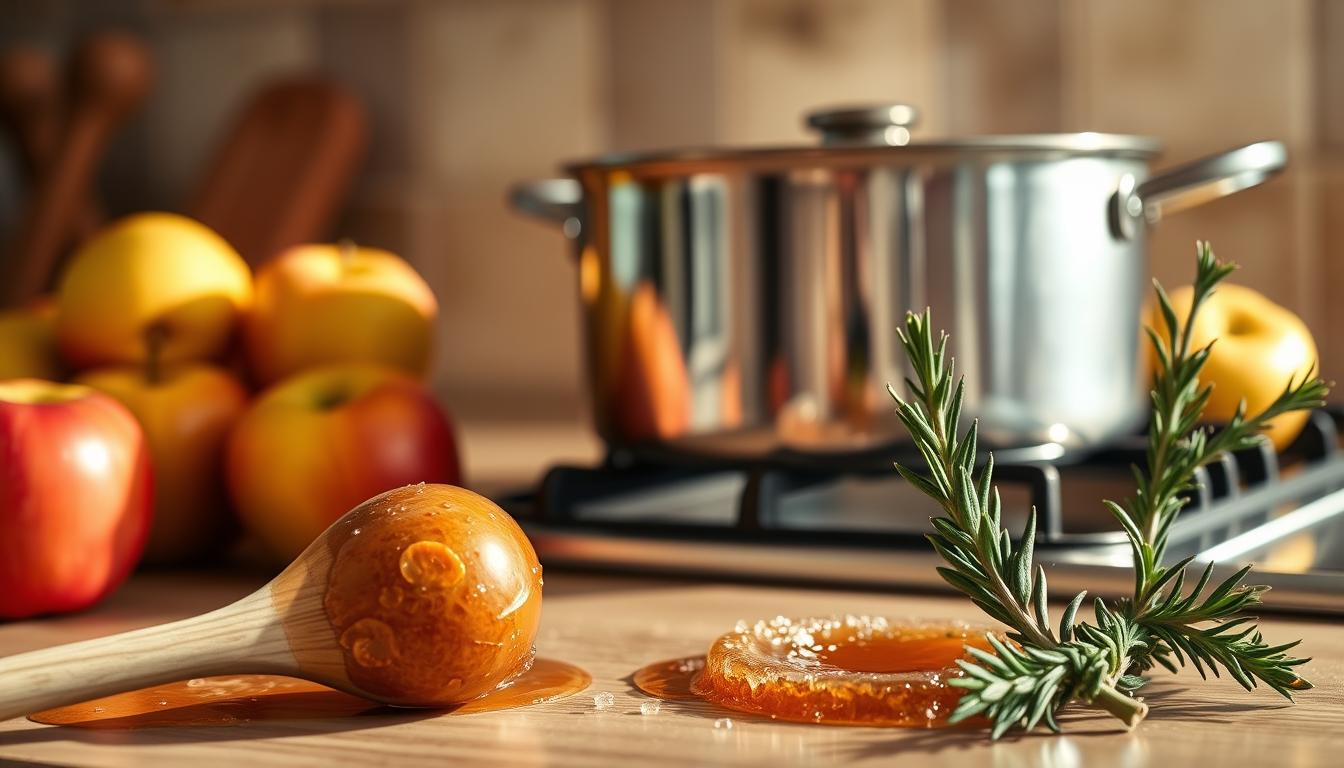Apple Cider Syrup
Welcome to the world of apple cider syrup. It’s a culinary treasure that makes ordinary dishes special. This syrup captures the essence of autumn, offering a deep flavor that enhances both sweet and savory recipes.
Apple cider syrup is more than just a pancake topping. It adds a warm, intense apple flavor to breakfast treats and gourmet desserts. This syrup can dramatically improve your cooking and baking.
In this guide, you’ll learn all about apple cider syrup. Whether you’re a home cook or a food enthusiast, you’ll find expert insights and practical techniques here.
Key Takeaways
- Discover the rich culinary potential of apple cider syrup
- Learn authentic homemade syrup-making techniques
- Explore versatile cooking and baking applications
- Understand the nutritional benefits of apple cider syrup
- Master storage and preservation methods
What Is Apple Cider Syrup and Its Origins
Apple cider syrup is a sweet, concentrated liquid that comes from apple cider. It’s a key part of American food culture. It turns apple cider into a versatile ingredient that captures the essence of autumn’s favorite fruit.

The story of apple cider syrup starts in New England’s historic orchards. Apple cultivation has been important there for centuries. Farmers found that making apple cider syrup was perfect for cooking.
Traditional New England Heritage
New England’s apple cider traditions go back to early colonial times. Settlers learned to make concentrated syrups to keep apples fresh through winter. They used:
- Slow cooking fresh apple cider
- Reducing liquid over open fires
- Preserving the intense apple flavor
Evolution of Apple Cider Processing
Apple cider processing has changed a lot over time. It went from simple farm methods to advanced techniques. Now, we have better filtration, controlled temperature, and flavor preservation.
| Era | Processing Method | Key Characteristics |
|---|---|---|
| Colonial Period | Open Fire Reduction | Manual, Labor-Intensive |
| Mid-20th Century | Industrial Cooking | Large-Scale Production |
| Modern Day | Precision Reduction | Quality-Controlled |
Modern Applications and Uses
Today, apple cider syrup is used in many ways. Chefs and home cooks love it for its versatility in sweet and savory dishes. It’s great for glazing meats or drizzling over desserts. It adds a burst of apple flavor to many recipes.
Benefits of Making Your Own Apple Cider Syrup

Making your own apple cider syrup at home is a fun and rewarding experience. It lets you control every step of the process. This means you can make it exactly how you like it.
There are many benefits to making your own syrup. It’s not just about following a recipe. It’s about enjoying the process and getting great results:
- Full control over ingredient quality
- Customizable sweetness levels
- Cost-effective alternative to store-bought options
- Potential for unique flavor combinations
When you make your own syrup, you can try out different apples and spices. Local apples from farmers markets can make your syrup truly special. It will taste like the region it comes from.
| Homemade Syrup Benefit | Impact |
|---|---|
| Ingredient Control | No artificial preservatives or additives |
| Cost Savings | Significantly cheaper than premium brands |
| Personalization | Unlimited flavor modification options |
Making apple cider syrup is more than just cooking. It’s a fun tradition for the fall season. Giving homemade syrup as gifts is a thoughtful way to show you care.
“Homemade apple cider syrup is not just a condiment, it’s an expression of culinary passion.”
Creating your own syrup connects you to traditional cooking. It also gives you a delicious ingredient to use in many recipes.
Essential Ingredients for Perfect Apple Cider Syrup
Making delicious apple cider syrup needs the right ingredients and tools. Start by knowing the key parts that make your syrup great.
Selecting the Right Apple Cider
The best apple cider syrup comes from top-notch apple cider. You have a few choices:
- Fresh pressed local apple cider
- Unfiltered organic apple cider
- Pure orchard-sourced apple cider
Pro tip: Pick apple cider with deep flavors from heirloom apples for the best taste.
Additional Spices and Flavorings
Add spices to your apple cider syrup for extra warmth and taste:
| Spice | Flavor Profile | Recommended Quantity |
|---|---|---|
| Cinnamon Stick | Warm, Sweet | 1-2 sticks per batch |
| Whole Nutmeg | Earthy, Aromatic | 1/4 grated nutmeg |
| Vanilla Bean | Rich, Smooth | 1/2 bean split |
Equipment Needed
Get your kitchen ready with these tools for making apple cider syrup:
- Heavy-bottom stainless steel pot
- Candy or digital thermometer
- Fine mesh strainer
- Glass storage bottles
- Wooden spoon
With the right ingredients and tools, you’re set to make a tasty apple cider syrup. It will wow your family and friends.
Step-by-Step Guide to Making Apple Cider Syrup at Home
Making your own apple cider syrup is a fun cooking adventure. It turns simple ingredients into a tasty condiment. With basic tools and patience, you can make a syrup that makes any dish better.
- High-quality apple cider
- Granulated sugar
- Optional spices like cinnamon or nutmeg
- Large heavy-bottomed pot
- Wooden spoon
- Candy thermometer
Here’s how to make your apple cider syrup:
- Pour apple cider into a large pot
- Add sugar and any desired spices
- Heat mixture over medium-high heat
- Stir constantly to prevent burning
- Cook until syrup reaches 220°F (soft-ball stage)
- Remove from heat and let cool slightly
For the best syrup, watch it closely and use a candy thermometer. Your syrup will thicken as it cools. It will become a rich, glossy condiment for many dishes.
Safety note: Always use caution when handling hot syrup to prevent burns.
Storage Tips and Shelf Life
Keeping your homemade apple cider syrup fresh is key. The right storage methods help you enjoy its sweet taste for months.
Best Storage Containers
Choosing the right container is vital. Glass containers are best because they:
- Prevent chemical interactions with the syrup
- Maintain the original flavor profile
- Allow easy visibility of the syrup’s condition
Preservation Methods
There are several ways to keep your syrup fresh:
- Refrigeration: The simplest method
- Canning for long-term storage
- Vacuum sealing to prevent oxidation
Signs of Spoilage
Look out for these signs that your syrup might spoil:
- Unusual mold growth
- Off-putting smell
- Significant color changes
- Fermentation or bubbling
Stored properly, your syrup can last 3-6 months in the fridge. Always use clean utensils to avoid contamination and keep it fresh longer.
Creative Ways to Use Apple Cider Syrup in Cooking
Apple cider syrup makes simple recipes into amazing dishes. It adds depth and flavor to both sweet and savory foods. It’s a must-have in your kitchen.
Here are some fun ways to use apple cider syrup in your cooking:
- Create glazes for roasted meats like chicken, pork, and ham
- Drizzle over breakfast favorites such as pancakes and waffles
- Use as a unique sweetener in baked goods like muffins and quick breads
- Enhance salad dressings with a splash of apple cider syrup
- Develop complex marinades for grilling and roasting
For savory dishes, apple cider syrup is amazing as a reduction sauce. Just simmer it with herbs and spices. This creates a rich, concentrated flavor. It’s perfect for drizzling over roasted veggies or grilled meats.
Baking fans will love using apple cider syrup. Swap traditional sugar with this syrup in recipes. It adds depth and complexity. Try it in apple pie, carrot cake, or homemade granola for a unique flavor.
“Apple cider syrup isn’t just a condiment—it’s a culinary adventure waiting to happen.”
Pro tip: Start with small amounts of apple cider syrup and adjust to taste. Its sweetness can overpower dishes if used too much.
Seasonal Recipes Featuring Apple Cider Syrup
Discover the magic of apple cider syrup in these seasonal recipes. They turn your homemade syrup into culinary wonders. Enjoy these recipes from morning to evening, making your cooking and baking better.
Learn how this sweet syrup can be your secret ingredient all year round.
Breakfast Creations
Begin your day with apple cider syrup-infused breakfasts that will delight your taste buds:
- Fluffy Cinnamon Apple Pancakes with warm apple cider syrup
- Crispy Belgian waffles with caramelized apple compote
- Overnight oats with a generous swirl of apple cider syrup
Decadent Dessert Recipes
Enhance your desserts with apple cider syrup’s rich flavors:
- Rustic apple pie with a syrup-glazed crust
- Spiced apple cake with a syrup reduction
- Homemade vanilla ice cream with apple cider syrup drizzle
Beverage Magic
Improve your drinks with apple cider syrup:
| Hot Beverages | Cold Drinks |
|---|---|
| Mulled Cider Toddy | Apple Cider Mojito |
| Spiced Chai Latte | Autumn Sangria |
| Hot Buttered Rum | Sparkling Apple Spritzer |
Each recipe highlights the depth and complexity of your homemade apple cider syrup. Experiment, enjoy, and let your creativity shine!
Health Considerations and Nutritional Value
Knowing what’s in apple cider syrup can guide your food choices. It’s not just tasty; it might also be good for you if you use it right.
Let’s look at what apple cider syrup has to offer:
- It has about 40-50 calories per tablespoon.
- It’s made from pure apple cider, so it’s full of natural sugars.
- It has a bit of vitamins and minerals.
- It might have antioxidants, which are good for you.
Apple cider syrup is a natural sweetener, but it’s high in sugar. People with diabetes or watching their sugar intake should use it carefully. It can raise blood sugar levels, so it’s important to not overdo it.
Compared to other sweeteners, apple cider syrup is less processed. It keeps some of the apple cider’s good stuff. The antioxidants in it might help your immune system.
If you’re on a special diet, apple cider syrup can be a tasty choice. It’s natural, which makes it good for those who want to avoid processed foods.
Pro tip: Moderation is key when enjoying apple cider syrup as part of a balanced diet.
Remember, apple cider syrup is calorie-dense. A little bit can add a lot of flavor and maybe some health benefits to your meals.
Troubleshooting Common Apple Cider Syrup Issues
Making apple cider syrup can sometimes present challenges, but don’t worry. Most issues are easily fixable with the right techniques. Understanding common problems will help you create perfect syrup every time.
Crystallization is a frequent concern when preparing apple cider syrup. This happens when sugar concentrates and forms solid crystals. To prevent this, stir your syrup consistently during cooking and avoid overheating. If crystals form, gently reheat the syrup while stirring to dissolve them.
- Check syrup consistency frequently during cooking
- Use a candy thermometer to monitor temperature
- Maintain medium-low heat for best results
Mold growth can occur if your apple cider syrup isn’t stored properly. Always use clean, sterilized containers and refrigerate after opening. A sealed container in the refrigerator can keep your syrup fresh for several weeks.
When your syrup becomes too thick, simply add a small amount of fresh apple cider to thin it out. Conversely, if the syrup is too thin, continue cooking to reduce and concentrate the liquid. Taste testing throughout the process helps you achieve the perfect apple cider syrup consistency.
- Thin syrup: Add fresh apple cider
- Thick syrup: Continue reducing
- Adjust heat and cooking time as needed
Burning is another potential issue when making syrup. To avoid this, use a heavy-bottomed pan and stir frequently. If a slight burning occurs, carefully transfer the syrup to a new pan, leaving the burned bottom behind.
With these tips, you’ll be able to troubleshoot and rescue your apple cider syrup, ensuring a delicious result every time.
Conclusion
Making your own apple cider syrup is more than a fun cooking project. It’s a way to capture the essence of autumn in a tasty liquid. This syrup can turn simple dishes into amazing meals. Your homemade syrup adds a personal touch that store-bought can’t match.
As you dive into making apple cider syrup, remember each batch is a unique creation. You can use it on pancakes, in marinades, or in drinks. It opens up a world of flavors for you to explore.
Your apple cider syrup journey is just starting. Try different apples, spices, and methods to make your own special syrup. Let it become a part of your autumn traditions, adding warmth and flavor to your meals.
The art of making apple cider syrup is about making memories and celebrating fall’s culinary heritage. Keep trying new things, tasting, and enjoying the homemade syrup world.


